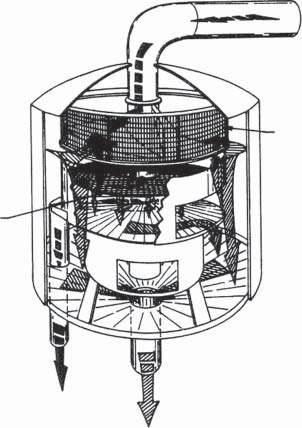Statistics and Probability with Applications for Engineers and Scientists using MINITAB, R and JMP,
Second Edition Bhisham C. Gupta
Visit to download the full and correct content document: https://ebookmass.com/product/statistics-and-probability-with-applications-for-engine ers-and-scientists-using-minitab-r-and-jmp-second-edition-bhisham-c-gupta/
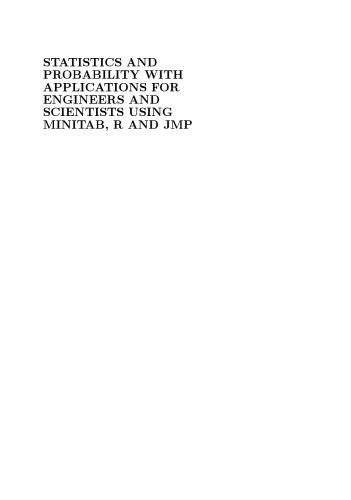
More products digital (pdf, epub, mobi) instant download maybe you interests ...
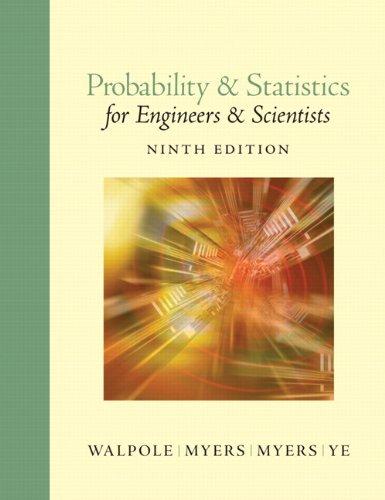
Probability & Statistics for Engineers & Scientists, 9th Edition
Ronald E. Walpole
https://ebookmass.com/product/probability-statistics-forengineers-scientists-9th-edition-ronald-e-walpole/
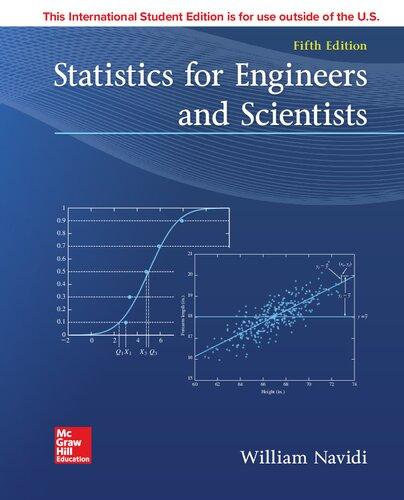
Statistics for Engineers and Scientists 5th Edition
William Navidi
https://ebookmass.com/product/statistics-for-engineers-andscientists-5th-edition-william-navidi-2/
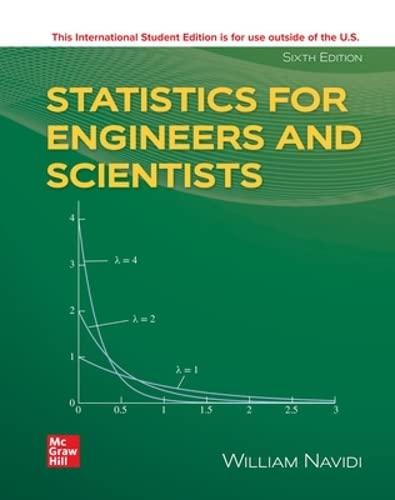
Statistics for Engineers and Scientists, 6th Edition
William Navidi
https://ebookmass.com/product/statistics-for-engineers-andscientists-6th-edition-william-navidi-2/

Statistics For Engineers and Scientists 6th Edition
William Navidi
https://ebookmass.com/product/statistics-for-engineers-andscientists-6th-edition-william-navidi/
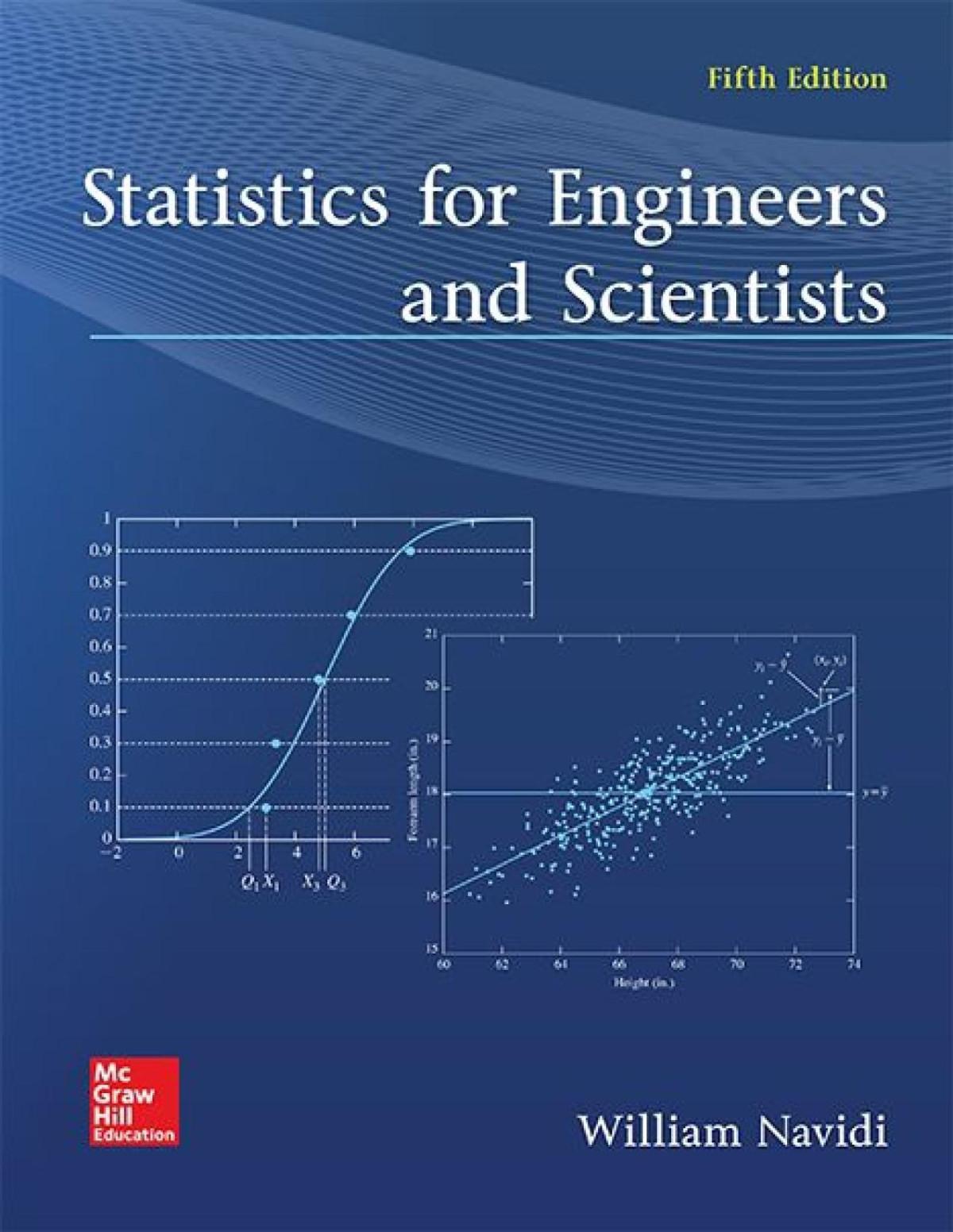
Statistics for Engineers and Scientists 5th Edition
William Navidi
https://ebookmass.com/product/statistics-for-engineers-andscientists-5th-edition-william-navidi/
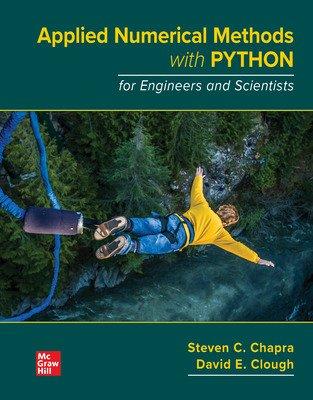
Applied Numerical Methods with Python for Engineers and Scientists Steven C. Chapra
https://ebookmass.com/product/applied-numerical-methods-withpython-for-engineers-and-scientists-steven-c-chapra/
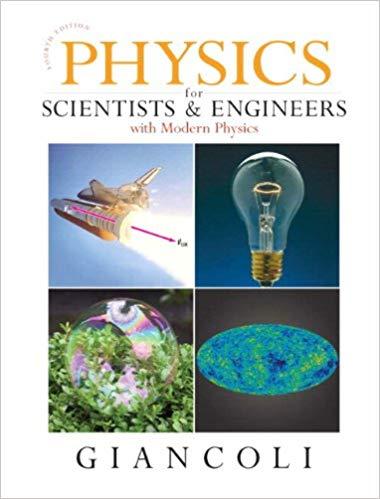
Physics for Scientists and Engineers with Modern Physics 4th Edition Douglas C. Giancoli
https://ebookmass.com/product/physics-for-scientists-andengineers-with-modern-physics-4th-edition-douglas-c-giancoli/
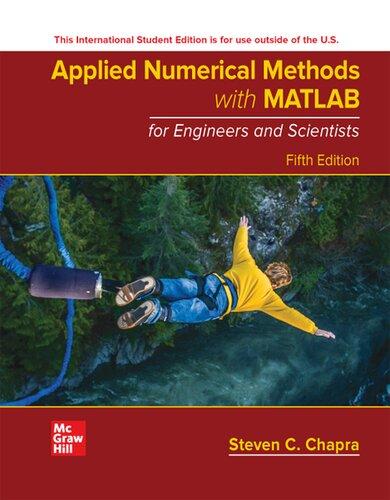
Applied Numerical Methods with MATLAB for Engineers and Scientists, 5th Edition Steven C. Chapra
https://ebookmass.com/product/applied-numerical-methods-withmatlab-for-engineers-and-scientists-5th-edition-steven-c-chapra/
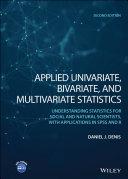
Applied Univariate, Bivariate, and Multivariate Statistics: Understanding Statistics for Social and Natural Scientists, With Applications in SPSS and R 2nd Edition Daniel J. Denis
https://ebookmass.com/product/applied-univariate-bivariate-andmultivariate-statistics-understanding-statistics-for-social-andnatural-scientists-with-applications-in-spss-and-r-2nd-editiondaniel-j-denis/
STATISTICSAND
PROBABILITYWITH APPLICATIONSFOR ENGINEERSAND
SCIENTISTSUSING MINITAB,RANDJMP
SecondEdition
BhishamC.Gupta
ProfessorEmeritusofStatistics
UniversityofSouthernMaine
Portland,ME
IrwinGuttman
ProfessorEmeritusofStatistics SUNYatBuffaloand
UniversityofToronto,Canada
KalankaP.Jayalath
AssistantProfessorofStatistics
UniversityofHouston–ClearLake
Houston,TX
Thissecondeditionfirstpublished2020
c 2020JohnWiley&Sons,Inc.
EditionHistory
JohnWiley&Sons,Inc.(1e,2013)
Allrightsreserved.Nopartofthispublicationmaybereproduced,storedinaretrievalsystem,ortransmitted, inanyformorbyanymeans,electronic,mechanical,photocopying,recordingorotherwise,exceptaspermitted bylaw.Adviceonhowtoobtainpermissiontoreusematerialfromthistitleisavailableathttp://www.wiley .com/go/permissions.
TherightofBhishamC.Gupta,IrwinGuttman,KalankaP.Jayalathtobeidentifiedastheauthorofthis workhasbeenassertedinaccordancewithlaw.
RegisteredOffice
JohnWiley&Sons,Inc.,111RiverStreet,Hoboken,NJ07030,USA
EditorialOffice
111RiverStreet,Hoboken,NJ07030,USA
Fordetailsofourglobaleditorialoffices,customerservices,andmoreinformationaboutWileyproductsvisit usatwww.wiley.com.
Wileyalsopublishesitsbooksinavarietyofelectronicformatsandbyprint-on-demand.Somecontentthat appearsinstandardprintversionsofthisbookmaynotbeavailableinotherformats.
LimitofLiability/DisclaimerofWarranty
Whilethepublisherandauthorshaveusedtheirbesteffortsinpreparingthiswork,theymakeno representationsorwarrantieswithrespecttotheaccuracyorcompletenessofthecontentsofthisworkand specificallydisclaimallwarranties,includingwithoutlimitationanyimpliedwarrantiesofmerchantabilityor fitnessforaparticularpurpose.Nowarrantymaybecreatedorextendedbysalesrepresentatives,writtensales materialsorpromotionalstatementsforthiswork.Thefactthatanorganization,website,orproductis referredtointhisworkasacitationand/orpotentialsourceoffurtherinformationdoesnotmeanthatthe publisherandauthorsendorsetheinformationorservicestheorganization,website,orproductmayprovideor recommendationsitmaymake.Thisworkissoldwiththeunderstandingthatthepublisherisnotengagedin renderingprofessionalservices.Theadviceandstrategiescontainedhereinmaynotbesuitableforyour situation.Youshouldconsultwithaspecialistwhereappropriate.Further,readersshouldbeawarethat websiteslistedinthisworkmayhavechangedordisappearedbetweenwhenthisworkwaswrittenandwhenit isread.Neitherthepublishernorauthorsshallbeliableforanylossofprofitoranyothercommercial damages,includingbutnotlimitedtospecial,incidental,consequential,orotherdamages.
LibraryofCongressCataloging-in-PublicationData
Names:Gupta,BhishamC.,1942-author. | Guttman,Irwin,author. | Jayalath,KalankaP.,author.
Title:Statisticsandprobabilitywithapplicationsforengineersand scientistsusingMinitab,RandJMP/BhishamC.Gupta,IrwinGuttman, KalankaP.Jayalath.
Othertitles:Statisticsandprobabilitywithapplicationsforengineers andscientists
Description:Secondedition. | Hoboken:Wiley,2020. | Revisionof: Statisticsandprobabilitywithapplicationsforengineersand scientists.2013. | Includesbibliographicalreferencesandindex. Identifiers:LCCN2019035384(print) | LCCN2019035385(ebook) | ISBN 9781119516637(cloth) | ISBN9781119516644(adobepdf) | ISBN 9781119516620(epub)
Subjects:LCSH:Probabilities. | Mathematicalstatistics. Classification:LCCQA273.G852020(print) | LCCQA273(ebook) | DDC 519.5–dc23
LCrecordavailableathttps://lccn.loc.gov/2019035384
LCebookrecordavailableathttps://lccn.loc.gov/2019035385
CoverDesign:Wiley
CoverImage: c ioat/Shutterstock
Setin10/12ptComputerModernbySPiGlobal,Chennai,India
PrintedintheUnitedStatesofAmerica
10987654321
Inthelovingmemoryofmyparents,RoshanLalandSodhanDevi -Bhisham
Inthelovingmemoryofmyparents,AnnaandSamuelGuttman -Irwin
Inthelovingmemoryofmyparents,PremadasaJayalathandChandraUnanthanna -Kalanka
1.1.1MotivationfortheStudy .....................2
1.1.2Investigation ............................3
1.1.3ChangingCriteria .........................3
1.1.4ASummaryoftheVariousPhasesoftheInvestigation
1.2ASurvey..................................6
1.3AnObservationalStudy ..........................6
1.4ASetofHistoricalData..........................7
1.5ABriefDescriptionofWhatisCoveredinthisBook...
PARTIFUNDAMENTALSOFPROBABILITYAND STATISTICS
2DESCRIBINGDATAGRAPHICALLYANDNUMERICALLY13
2.1GettingStartedwithStatistics ......................14
2.1.1WhatIsStatistics?
2.1.2PopulationandSampleinaStatisticalStudy...
2.2ClassificationofVariousTypesofData
2.2.1NominalData
2.2.2OrdinalData
2.2.3IntervalData
2.2.4RatioData .............................19
2.3FrequencyDistributionTablesforQualitativeandQuantitativeData.20
2.3.1QualitativeData ..........................21
2.3.2QuantitativeData
2.4GraphicalDescriptionofQualitativeandQuantitativeData
2.4.1DotPlot.
2.4.2PieChart
2.4.3BarChart
2.4.4Histograms
2.4.5LineGraph
2.4.6Stem-and-LeafPlot
2.5NumericalMeasuresofQuantitativeData
2.5.1MeasuresofCentrality .......................51
2.5.2MeasuresofDispersion
2.6NumericalMeasuresofGroupedData..................67
2.6.1MeanofaGroupedData
2.6.2MedianofaGroupedData ....................68
2.6.3ModeofaGroupedData .....................69
2.6.4VarianceofaGroupedData ....................69
2.7MeasuresofRelativePosition .......................70
2.7.1Percentiles ..............................71
2.7.2Quartiles ..............................72
2.7.3InterquartileRange(IQR)
2.7.4CoefficientofVariation ......................73
2.8Box-WhiskerPlot..............................75
2.8.1ConstructionofaBoxPlot ....................75
2.8.2HowtoUsetheBoxPlot .....................76
2.9MeasuresofAssociation ..........................80
2.10CaseStudies.. ..............................84
2.10.1AboutSt.Luke’sHospital .....................85
2.11UsingJMP... ..............................86
3ELEMENTSOFPROBABILITY97
3.1Introduction... ..............................97
3.2RandomExperiments,SampleSpaces,andEvents...........98
3.2.1RandomExperimentsandSampleSpaces
3.2.2Events.. ..............................99
3.3ConceptsofProbability ..........................103
3.4TechniquesofCountingSamplePoints..................108
3.4.1TreeDiagram ............................108
3.4.2Permutations ............................110
3.4.3Combinations ............................110
3.4.4Arrangementsof n ObjectsInvolvingSeveralKindsofObjects111
3.5ConditionalProbability ..........................113
3.6Bayes’sTheorem..............................116
3.7IntroducingRandomVariables ......................120 ReviewPracticeProblems.........................122
4DISCRETERANDOMVARIABLESANDSOMEIMPORTANT DISCRETEPROBABILITYDISTRIBUTIONS128
4.1GraphicalDescriptionsofDiscreteDistributions .............129
4.2MeanandVarianceofaDiscreteRandomVariable...........130
4.2.1ExpectedValueofDiscreteRandomVariablesandTheirFunctions130
4.2.2TheMoment-GeneratingFunction-ExpectedValueofaSpecial Functionof X ............................133
4.3TheDiscreteUniformDistribution
4.4TheHypergeometricDistribution
4.5TheBernoulliDistribution
4.6TheBinomialDistribution
4.7TheMultinomialDistribution .......................146
4.8ThePoissonDistribution ..........................147
4.8.1DefinitionandPropertiesofthePoissonDistribution ......147
4.8.2PoissonProcess ...........................148
4.8.3PoissonDistributionasaLimitingFormoftheBinomial ....148
4.9TheNegativeBinomialDistribution ...................153
4.10SomeDerivationsandProofs(Optional) .................156
4.11ACaseStudy.. ..............................156
4.12UsingJMP... ..............................157 ReviewPracticeProblems.........................157
5CONTINUOUSRANDOMVARIABLESANDSOMEIMPORTANT CONTINUOUSPROBABILITYDISTRIBUTIONS164
5.1ContinuousRandomVariables.......................165
5.2MeanandVarianceofContinuousRandomVariables..........168
5.2.1ExpectedValueofContinuousRandomVariablesandTheir Functions ..............................168
5.2.2TheMoment-GeneratingFunctionandExpectedValueofaSpecial Functionof X ............................171
5.3Chebyshev’sInequality ...........................173
5.4TheUniformDistribution .........................175
5.4.1DefinitionandProperties .....................175
5.4.2MeanandStandardDeviationoftheUniformDistribution..178
5.5TheNormalDistribution ..........................180
5.5.1DefinitionandProperties .....................180
5.5.2TheStandardNormalDistribution ................182
5.5.3TheMoment-GeneratingFunctionoftheNormalDistribution.187
5.6DistributionofLinearCombinationofIndependentNormalVariables.189
5.7ApproximationoftheBinomialandPoissonDistributionsbytheNormal Distribution... ..............................193
5.7.1ApproximationoftheBinomialDistributionbytheNormal Distribution .............................193
5.7.2ApproximationofthePoissonDistributionbytheNormal Distribution .............................196
5.8ATestofNormality ............................196
5.9ProbabilityModelsCommonlyusedinReliabilityTheory .......201
5.9.1TheLognormalDistribution ....................202
5.9.2TheExponentialDistribution ...................206
5.9.3TheGammaDistribution .....................211
5.9.4TheWeibullDistribution .....................214
5.10ACaseStudy.. ..............................218
5.11UsingJMP... ..............................219 ReviewPracticeProblems.........................220
6DISTRIBUTIONOFFUNCTIONSOFRANDOMVARIABLES228
6.1Introduction... ..............................229
6.2DistributionFunctionsofTwoRandomVariables ............229
6.2.1CaseofTwoDiscreteRandomVariables .............229
6.2.2CaseofTwoContinuousRandomVariables ...........232
6.2.3TheMeanValueandVarianceofFunctionsofTwoRandom Variables..............................233
6.2.4ConditionalDistributions .....................235
6.2.5CorrelationbetweenTwoRandomVariables ...........238
6.2.6BivariateNormalDistribution ...................241
6.3ExtensiontoSeveralRandomVariables.................244
6.4TheMoment-GeneratingFunctionRevisited ...............245 ReviewPracticeProblems.........................249
7SAMPLINGDISTRIBUTIONS253
7.1RandomSampling.............................253
7.1.1RandomSamplingfromanInfinitePopulation..
7.1.2RandomSamplingfromaFinitePopulation ...........256
7.2TheSamplingDistributionoftheSampleMean
7.2.1NormalSampledPopulation
7.2.2NonnormalSampledPopulation
7.2.3TheCentralLimitTheorem
7.3SamplingfromaNormalPopulation ...................264
7.3.1TheChi-SquareDistribution ...................264
7.3.2TheStudent t-Distribution
7.3.3Snedecor’s F -Distribution .....................276
7.4OrderStatistics. ..............................279
7.4.1DistributionoftheLargestElementinaSample. .......280
7.4.2DistributionoftheSmallestElementinaSample. .......281
7.4.3DistributionoftheMedianofaSampleandofthe kth Order Statistic. ..............................282
7.4.4OtherUsesofOrderStatistics ..................284
7.5UsingJMP.................................286 ReviewPracticeProblems.........................286
8ESTIMATIONOFPOPULATIONPARAMETERS289
8.1Introduction... ..............................290
8.2PointEstimatorsforthePopulationMeanandVariance. .......290
8.2.1PropertiesofPointEstimators ..................292
8.2.2MethodsofFindingPointEstimators ..............295
8.3IntervalEstimatorsfortheMean μ ofaNormalPopulation ......301
8.3.1 σ 2
8.3.2 σ 2
8.3.3SampleSizeIsLarge ........................306
8.4IntervalEstimatorsforTheDifferenceofMeansofTwoNormal Populations... ..............................313
8.4.1VariancesAreKnown .......................313
8.4.2VariancesAreUnknown ......................314
8.5IntervalEstimatorsfortheVarianceofaNormalPopulation ......322
8.6IntervalEstimatorfortheRatioofVariancesofTwoNormal Populations... ..............................327
8.7PointandIntervalEstimatorsfortheParametersofBinomialPopulations331
8.7.1OneBinomialPopulation .....................331
8.7.2TwoBinomialPopulations .....................334
8.8DeterminationofSampleSize .......................338
8.8.1OnePopulationMean .......................339
8.8.2DifferenceofTwoPopulationMeans ...............339
8.8.3OnePopulationProportion ....................340
8.8.4DifferenceofTwoPopulationProportions ............341
8.9SomeSupplementalInformation ......................343
8.10ACaseStudy.. ..............................343
8.11UsingJMP... ..............................343 ReviewPracticeProblems.........................344
9HYPOTHESISTESTING352
9.1Introduction... ..............................353
9.2BasicConceptsofTestingaStatisticalHypothesis
9.2.1HypothesisFormulation ......................353
9.2.2RiskAssessment ..........................355
9.3TestsConcerningtheMeanofaNormalPopulationHavingKnown Variance...................................358
9.3.1CaseofaOne-Tail(Left-Sided)Test
9.3.2CaseofaOne-Tail(Right-Sided)Test ..............362
9.3.3CaseofaTwo-TailTest ......................363
9.4TestsConcerningtheMeanofaNormalPopulationHavingUnknown Variance...................................372
9.4.1CaseofaLeft-TailTest ......................372
9.4.2CaseofaRight-TailTest .....................373
9.4.3TheTwo-TailCase .........................374
9.5LargeSampleTheory............................378
9.6TestsConcerningtheDifferenceofMeansofTwoPopulationsHaving DistributionswithKnownVariances ...................380
9.6.1TheLeft-TailTest .........................380
9.6.2TheRight-TailTest ........................381
9.6.3TheTwo-TailTest .........................383
9.7TestsConcerningtheDifferenceofMeansofTwoPopulationsHaving NormalDistributionswithUnknownVariances .............388
9.7.1TwoPopulationVariancesareEqual ...............388
9.7.2TwoPopulationVariancesareUnequal ..............392
9.7.3ThePaired t-Test..........................395
9.8TestingPopulationProportions ......................401
9.8.1TestConcerningOnePopulationProportion ...........401
9.8.2TestConcerningtheDifferenceBetweenTwoPopulation Proportions .............................405
9.9TestsConcerningtheVarianceofaNormalPopulation..
9.10TestsConcerningtheRatioofVariancesofTwoNormalPopulations.414
9.11TestingofStatisticalHypothesesusingConfidenceIntervals ......418
9.12SequentialTestsofHypotheses ......................422
9.12.1AOne-TailSequentialTestingProcedure
9.12.2ATwo-TailSequentialTestingProcedure
9.13CaseStudies..
9.14UsingJMP...
PARTIISTATISTICSINACTIONS
10.1.1TheHazardRateFunction
10.4Estimation:WeibullDistribution
10.5CaseStudies..
11ONDATAMINING476
11.1Introduction...
11.2WhatisDataMining?
11.2.1BigData
11.3DataReduction.
11.4DataVisualization
11.5DataPreparation
11.5.1MissingData
11.5.2OutlierDetectionandRemedialMeasures
11.6.1EvaluatingaClassificationModel
11.7DecisionTrees..
11.7.1ClassificationandRegressionTrees(CART)
11.7.2FurtherReading
11.8CaseStudies..
11.9UsingJMP...
12.1Introduction...
12.2SimilarityMeasures
12.2.1CommonSimilarityCoefficients
12.3HierarchicalClusteringMethods
12.3.1SingleLinkage
12.3.2CompleteLinkage
12.3.3AverageLinkage
12.3.4Ward’sHierarchicalClustering
12.4NonhierarchicalClusteringMethods
12.4.1 K
12.5Density-BasedClustering
12.7ACaseStudy..
12.8UsingJMP...
13ANALYSISOFCATEGORICALDATA558
13.1Introduction...
13.2TheChi-SquareGoodness-of-FitTest
13.3ContingencyTables
13.3.1The2 × 2CasewithKnownParameters
13.3.2The2 × 2CasewithUnknownParameters
13.3.3The r × s ContingencyTable
13.4Chi-SquareTestforHomogeneity
13.5CommentsontheDistributionoftheLack-of-FitStatistics
13.6CaseStudies..
13.7UsingJMP... ..............................584
14NONPARAMETRICTESTS591
14.1Introduction... ..............................591
14.2TheSignTest.. ..............................592
14.2.1One-SampleTest ..........................592
14.2.2TheWilcoxonSigned-RankTest .................595
14.2.3Two-SampleTest ..........................598
14.3Mann–Whitney(Wilcoxon) W TestforTwoSamples..........604
14.4RunsTest ..................................608
14.4.1RunsaboveandbelowtheMedian ................608
14.4.2TheWald–WolfowitzRunTest ..................611
14.5SpearmanRankCorrelation ........................614
14.6UsingJMP... ..............................618 ReviewPracticeProblems.........................618
15SIMPLELINEARREGRESSIONANALYSIS622
15.1Introduction... ..............................623
15.2FittingtheSimpleLinearRegressionModel ...............624
15.2.1SimpleLinearRegressionModel .................624
15.2.2FittingaStraightLinebyLeastSquares .............627
15.2.3SamplingDistributionoftheEstimatorsofRegressionCoefficients631
15.3UnbiasedEstimatorof σ 2 .........................637
15.4FurtherInferencesConcerningRegressionCoefficients(β0 , β 1 ), E (Y ),and Y .......................................639
15.4.1ConfidenceIntervalfor β1 withConfidenceCoefficient(1 α).639
15.4.2ConfidenceIntervalfor β0 withConfidenceCoefficient(1 α).640
15.4.3ConfidenceIntervalfor E (Y |X )withConfidenceCoefficient (1 α)...............................642
15.4.4PredictionIntervalforaFutureObservation Y withConfidence Coefficient(1 α).........................645
15.5TestsofHypothesesfor β0 and β1 .....................652
15.5.1TestofHypothesesfor β1 .....................652
15.5.2TestofHypothesesfor β0 .....................652
15.6AnalysisofVarianceApproachtoSimpleLinearRegressionAnalysis.659
15.7ResidualAnalysis ..............................665
15.8Transformations ..............................674
15.9InferenceAbout ρ .............................681
15.10ACaseStudy.. ..............................683
15.11UsingJMP...
16MULTIPLELINEARREGRESSIONANALYSIS693
16.1Introduction... ..............................694
16.2MultipleLinearRegressionModels ....................694
16.3EstimationofRegressionCoefficients ...................699
16.3.1EstimationofRegressionCoefficientsUsingMatrixNotation.701
16.3.2PropertiesoftheLeast-SquaresEstimators ...........703
16.3.3TheAnalysisofVarianceTable ..................704
16.3.4MoreInferencesaboutRegressionCoefficients... .......706
16.4MultipleLinearRegressionModelUsingQuantitativeandQualitative PredictorVariables.............................714
16.4.1SingleQualitativeVariablewithTwoCategories. .......714
16.4.2SingleQualitativeVariablewithThreeorMoreCategories...716
16.5StandardizedRegressionCoefficients
16.5.1Multicollinearity ..........................728
16.5.2ConsequencesofMulticollinearity
16.6BuildingRegressionTypePredictionModels ..............730
16.6.1FirstVariabletoEnterintotheModel ..............730
16.7ResidualAnalysisandCertainCriteriaforModelSelection ......734
16.7.1ResidualAnalysis ..........................734
16.7.2CertainCriteriaforModelSelection
16.8LogisticRegression .............................740
16.9CaseStudies.. ..............................745
17.2.1EstimableParameters
17.2.2EstimableFunctions ........................760
17.3One-WayExperimentalLayouts
17.3.1TheModelandItsAnalysis
17.3.2ConfidenceIntervalsforTreatmentMeans ............767
17.3.3MultipleComparisons .......................773
17.3.4DeterminationofSampleSize ...................780
17.3.5TheKruskal–WallisTestforOne-WayLayouts(Nonparametric Method)...............................781
17.4RandomizedCompleteBlock(RCB)Designs ..............785
17.4.1TheFriedman Fr -TestforRandomizedCompleteBlockDesign (NonparametricMethod).....................792
17.4.2ExperimentswithOneMissingObservationinanRCB-Design Experiment.............................794
17.4.3ExperimentswithSeveralMissingObservationsinanRCB-Design Experiment.............................795
17.5Two-WayExperimentalLayouts .....................798
17.5.1Two-WayExperimentalLayoutswithOneObservationperCell800
17.5.2Two-WayExperimentalLayoutswith r> 1ObservationsperCell801
17.5.3BlockinginTwo-WayExperimentalLayouts ...........810
17.5.4ExtendingTwo-WayExperimentalDesignsto n-Way ExperimentalLayouts.......................811
17.6LatinSquareDesigns ............................813
17.7Random-EffectsandMixed-EffectsModels ................820
17.7.1Random-EffectsModel .......................820
17.7.2Mixed-EffectsModel ........................822
17.7.3Nested(Hierarchical)Designs ...................824
18.1Introduction...
18.2TheFactorialDesigns
18.3The2k FactorialDesigns..........................850
18.4Unreplicated2k FactorialDesigns.....................859
18.5Blockinginthe2k FactorialDesign....................867
18.5.1Confoundinginthe2k FactorialDesign.............867
18.5.2Yates’sAlgorithmforthe2k FactorialDesigns.........875
18.6The2k FractionalFactorialDesigns ....................877
18.6.1One-halfReplicateofa2k FactorialDesign...........877
18.6.2One-quarterReplicateofa2k FactorialDesign.........882
18.7CaseStudies..
18.8UsingJMP...
19.1Introduction...
19.1.1BasicConceptsofResponseSurfaceMethodology. .......898 19.2First-OrderDesigns
19.3Second-OrderDesigns
19.3.1CentralCompositeDesigns(CCDs)
19.3.2SomeOtherFirst-OrderandSecond-OrderDesigns .......928
19.4DeterminationofOptimumorNear-OptimumPoint...
19.4.1TheMethodofSteepestAscent
19.4.2AnalysisofaFittedSecond-OrderResponseSurface
19.5AnovaTableforaSecond-OrderModel
19.6CaseStudies..
19.7UsingJMP...
Modernstatisticiansarefamiliarwiththenotionthatanyfinitebodyofdatacontainsonly alimitedamountofinformationonanypointunderexamination;thatthislimitissetby thenatureofthedatathemselves,andcannotbeincreasedbyanyamountofingenuity expendedintheirstatisticalexamination:thatthestatistician’stask,infact,islimitedto theextractionofthewholeoftheavailableinformationonanyparticularissue.
R.A.Fisher
Preface
AUDIENCE
Thisisanintroductorytextbookinappliedstatisticsandprobabilityforundergraduate studentsinengineeringandthenaturalsciences.Itbeginsatalevelsuitableforthosewith nopreviousexposuretoprobabilityandstatisticsandcarriesthereaderthroughtoalevel ofproficiencyinvarioustechniquesofstatistics.Thistextisdividedintotwoparts:PartI discussesdescriptivestatistics,conceptsofprobability,probabilitydistributions,sampling distributions,estimation,andtestingofhypotheses,andPartIIdiscussesvarioustopics ofappliedstatistics,includingsomereliabilitytheory,datamining,clusteranalysis,some nonparametrictechniques,categoricaldataanalysis,simpleandmultiplelinearregression analysis,designandanalysisofvariancewithemphasison2k factorialdesigns,response surfacemethodology,andstatisticalqualitycontrolchartsofphaseIandphaseII.
Thistextissuitableforaone-ortwo-semesterundergraduatecoursesequence.The presentationofmaterialgivesinstructorsalotofflexibilitytopickandchoosetopics theyfeelshouldmakeupthecoverageofmaterialfortheircourses.However,wefeelthat inthefirstcourseforengineersandsciencemajors,onemaycoverChapter1and2,a briefdiscussionofprobabilityinChapter3,selecteddiscreteandcontinuousdistributions fromChapter4and5withmoreemphasisonnormaldistribution,Chapter7–9,and coupleoftopicsfromPartIIthatmeettheneedsandinterestsoftheparticulargroupof students.Forexample,somediscussionofthematerialonregressionanalysisanddesign ofexperimentsinChapter15and17mayservewell.Chapter11and12maybeadequate tomotivatestudents’interestindatascienceanddataanalytics.Atwo-semestercourse maycovertheentirebook.Theonlyprerequisiteisafirstcourseincalculus,whichall engineeringandsciencestudentsarerequiredtotake.Becauseofspaceconsiderations, someproofsandderivations,certainadvancedleveltopicsofinterest,includingChapter 20and21onstatisticalqualitycontrolchartsofphaseIandphaseII,arenotincludedin thetextbutareavailablefordownloadviathebook’swebsite:www.wiley.com/college/ gupta/statistics2e.
MOTIVATION
Studentsencounterdata-analysisproblemsinmanyareasofengineeringornaturalscience curricula.Engineersandscientistsintheirprofessionallivesoftenencountersituations requiringanalysisofdataarisingfromtheirareasofpractice.Veryoften,theyhaveto plantheinvestigationthatgeneratesdata(anactivityeuphemisticallycalledthedesign ofexperiments),analyzesthedataobtained,andinterpretstheresults.Otherproblems andinvestigationsmaypertaintothemaintenanceofqualityofexistingproductsorthe developmentofnewproductsortoadesiredoutcomeinaninvestigationoftheunderlying mechanismsgoverningacertainprocess.Knowinghowto“design”aparticularinvestigationtoobtainreliabledatamustbecoupledwithknowledgeofdescriptiveandinferential statisticaltoolstoanalyzeproperlyandinterpretsuchdata.Theintentofthistextbookis
toexposetheuninitiatedtostatisticalmethodsthatdealwiththegenerationofdatafor different(butfrequentlymet)typesofinvestigationsandtodiscusshowtoanalyzeand interpretthegenerateddata.
HISTORY
ThistexthasitsrootsinthethreeeditionsofIntroductoryEngineeringStatistics,first co-authoredbyIrwinGuttmanandthelate,greatSamuelWilks.ProfessorJ.Stuart Hunter(PrincetonUniversity),oneofthefinestexpositorsinthestatisticsprofession,a notedresearcher,andacolleagueofProfessorWilks,joinedProfessorGuttmantoproduce editionstwoandthree.AlleditionswerepublishedbyJohnWiley&Sons,withthethird editionappearingin1982.Thefirsteditionofthecurrenttextwaspublishedin2013.
APPROACH
Inthistext,weemphasizebothdescriptiveandinferentialstatistics.Wefirstgivedetailsof descriptivestatisticsandthencontinuewithanelementarydiscussionofthefundamentals ofprobabilitytheoryunderlyingmanyofthestatisticaltechniquesdiscussedinthistext. Wenextcoverawiderangeofstatisticaltechniquessuchasstatisticalestimation,regressionmethods,nonparametricmethods,elementsofreliabilitytheory,statisticalquality control(withemphasisonphaseIandphaseIIcontrolcharts),andprocesscapability indices,andthelike.Afeatureofthesediscussionsisthatallstatisticalconceptsaresupportedbyalargenumberofexamplesusingdataencounteredinreal-lifesituations.We alsoillustratehowthestatisticalpackagesMINITAB R Version18,R R Version3.5.1,and JMP R Version9,maybeusedtoaidintheanalysisofvariousdatasets.
Anotherfeatureofthistextisthecoverageatanadequateandunderstandablelevel ofthedesignofexperiments.Thisincludesadiscussionofrandomizedblockdesigns, one-andtwo-waydesigns,Latinsquaredesigns,2k factorialdesigns,responsesurface designs,amongothers.Thelatestversionofthistextcoversmaterialsonsupervisedand unsupervisedlearningtechniquesusedindataminingandclusteranalysiswithagreat exposureinstatisticalcomputingusingRsoftwareandMINITAB.Aspreviouslyindicated, allthisisillustratedwithreal-lifesituationsandaccompanyingdatasets,supportedby MINITAB,R,andJMP.Weknowofnootherbookinthemarketthatcoversallthese softwarepackages.
WHATISNEWINTHISEDITION
Afteracarefulinvestigationofthecurrenttechnologicaladvancementinstatistical softwareandrelatedapplicationsaswellasthefeedbackreceivedfromthecurrent usersofthetext,wehavesuccessfullyincorporatedmanychangesinthisnewedition.
• RsoftwareexhibitsalongwiththeirRcodeareincluded.
• AdditionalRsoftwarehelpforbeginnersisincludedinAppendixD.
• MINITABsoftwareinstructionsandcontentsareupdatedtoitslatestedition.
• JMPsoftwareinstructionsandcontentsareupdatedtoitslatestedition.
• NewchaptersonDataMiningandClusteranalysisareincluded.
• AnimprovedchapteronResponseSurfaceDesignhasbroughtbacktotheprinted copyfromthebookwebsite.
• The p-valueapproachisemphasized,andrelatedpracticalinterpretationsare included.
• Thevisibilityofthetheoremsanddefinitionsareimprovedandwellformatted.
• Graphicalexhibitsareprovidedtoimprovethevisualizations.
Aspreviouslyindicated,weincorporateMINITABandRthroughoutthetextand completeRexhibitswiththeiroutputs(AppendixD)andassociatedJMPexhibits areavailableonthebook’swebsite:www.wiley.com/college/gupta/statistics2e.Our step-by-stepapproachtotheuseofthesoftwarepackagesmeansnopriorknowledge oftheiruseisrequired.Aftercompletingacoursethatusesthistext,studentswill beabletousethesesoftwarepackagestoanalyzestatisticaldataintheirfieldsof interest.
BreadthofCoverage
Besidesthecoverageofmanypopularstatisticaltechniques,weincludediscussion ofcertainaspectsofsamplingdistributions,nonparametrictests,reliabilitytheory, datamining,clusteranalysis,analysisofcategoricaldata,simpleandmultiplelinear regression,designofexperiments,responsesurfacemethodology,andphaseIand phaseIIcontrolcharts.
Designofexperiments,responsesurfacemethodology,regressionanalysis aretreatedinsufficientbreadthanddepthtobeappropriateforatwo-coursesequencein engineeringstatisticsthatincludesprobabilityandthedesignofexperiments.
Realdata inexamplesandhomeworkproblemsillustratetheimportanceofstatistics andprobabilityasatoolforengineersandscientistsintheirprofessionallives.Allthedata setswith20ormoredatapointsareavailableonthewebsiteinthreeformats:MINITAB, MicrosoftExcel,andJMP.
Casestudies inmostchaptersfurtherillustratetheimportanceofstatisticaltechniquesinprofessionalpractice.
STUDENTRESOURCES
Datasetsforallexamplesandhomeworkexercises fromthetextareavailable tostudentsonthewebsiteinMINITAB,MicrosoftExcel,andJMPformat.The sampledatasetsweregeneratedusingwell-knownstatisticalsamplingprocedures,
ensuringthatwearedealingwithrandomsamples.Aninklingofwhatthismayentail isgiventhroughoutthetext(see,forexample,Section7.1.2).Thefieldofsampling isanactivetopicamongresearchstatisticiansandpractitioners,andreferencesto samplingtechniquesarewidelyavailableinbooksandjournalarticles.Someofthese referencesareincludedinthebibliographysection.
Otherresourcesonthebookwebsitewww.wiley.com/college/gupta/statistics2e availablefordownloadinclude:
SolutionsManual toalloddnumberedhomeworkexercisesinthetext.
INSTRUCTORRESOURCES
Thefollowingresourcesareavailabletoadoptinginstructorsonthetextbook website:www.wiley.com/college/gupta/statistics2e.
SolutionsManual toallhomeworkexercisesinthetext. Lectureslides toaidinstructorspreparingforlectures. Datasetsforallexamplesandhomeworkexercises fromthebook,inthree formats:Minitab,MicrosoftExcel,andJMP.
Errata Wehavethoroughlyreviewedthetexttomakesureitisaserror-freeas possible.However,anyerrorsdiscoveredwillbelistedonthetextbookwebsite.Ifyou encounteranyerrorsasyouareusingthebook,pleasesendthemdirectlytotheauthors bcgupta@maine.edu,sothattheerrorscanbecorrectedinatimelymanneronthewebsite, andforfutureeditions.Wealsowelcomeanysuggestionsforimprovementyoumayhave, andthankyouinadvanceforhelpingusimprovethebookforfuturereaders.


